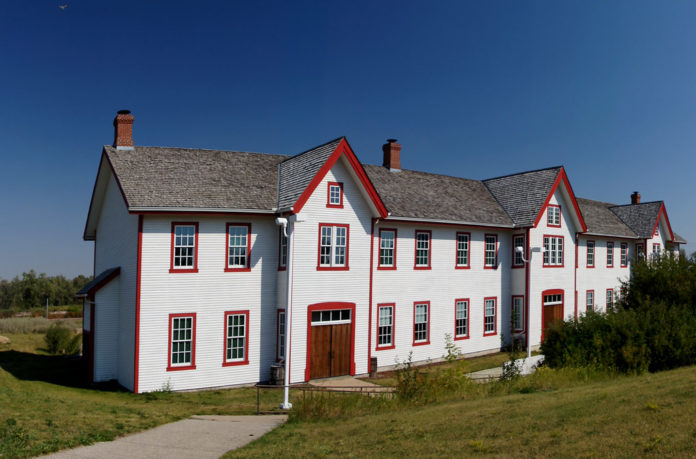750 9 Avenue SE
by Jocelyn Taylor
This month, we’re going to take a look at Fort Calgary. Now, I recognize that it is cold out, and likely not the best time to go venture out and explore outdoorsy places. My hope, however, is that this is somewhere that can be added to your spring/summer/fall (which, in Calgary, could all occur in one day) excursions! Fort Calgary is located at the intersection of the Bow and Elbow Rivers, which provides a stunning spot for photographs. Additionally, if you’re making a day of it, St. Patrick’s Island is across the river, and is one of the loveliest parks in the city.
Fort Calgary was constructed in 1875, and is now a federally and provincially recognized and protected site. Back in the day, in roughly 1874, the North-West Mounted Police sent a group of 150 men from Manitoba to what is now Calgary, which allowed for settlement in the area. Why did they head out here, you ask? Well, there was some shady business afoot. There was illegal whiskey trading occurring throughout the country, so Prime Minister Sir John A. Macdonald created the North-West Mounted Police to intercept these trades and shut down the whiskey-invasion. Personally, this sounds like the perfect way to get free whiskey, but that’s none of my business…
Once the men reached the area, they began construction on their base. Fort Calgary was one of the first North-West Mounted Police Outposts in western Canada. The building of the outpost led to the establishment of permanent settlements in the area. Around this time, the Canadian Pacific Railroad was consistently expanding across the country, which made settlement in the area more lucrative. By 1883, the whiskey and buffalo trade had slowed, but the CPR had arrived, which ensured people stayed, and that growth would continue.
As per most historical events, the establishment of Fort Calgary was not free of controversy. Ephrem-A. Brisebois was one of the commanding officers in the North-West Mounted Police. He was appointed by Sir John A. Macdonald because he possessed military experience (he fought in the American Civil War), and was also a Conservative. Fair warning, this is where the story gets rather problematic. When the fort was being established, it was initially named Fort Brisebois; however, he was unable to establish discipline among his men, and, unfortunately, there was discrimination against his common-law wife due to her Metis heritage. This led to some major drama between him and his division and his superior officer, James Macleod, prompting an eventual name change. Named after Calgary House, a castle at Calgary Bay on the Isle of Mull in Scotland, Fort Calgary was born.
So, what is happening there now? Well, the City of Calgary purchased Fort Calgary in 1974, and was reopened as a historical site and museum in 1978. Today, the Fort is undergoing significant changes, due to the work of the Fort Calgary Preservation Society. In 2006, a three-phase plan was unveiled, with each phase tackling a different portion of the area. Phase one restored the Deane and Hunt houses, which are located in the same area as Fort Calgary. The second phase was the installation of Markings¸ the 1875 Fort Interpretation Exhibit. The final phase is the New Museum Project, which will create a new 12,750 square-foot museum and a partial renovation of the barracks from 1888. Fort Calgary provides a glimpse into what life would have been like back in the day, allowing visitors to reflect on the changes to the city, while also appreciating the work of those who came before us. Additionally, the work of organizations like the Fort Calgary Preservation Society ensure that historical landmarks continue to evolve, creating a strong connection to the past in our modern society. I hope you’re able to go and check it out!
Information courtesy of the City of Calgary Inventory of Historic Resources and www.FortCalgary.com.









